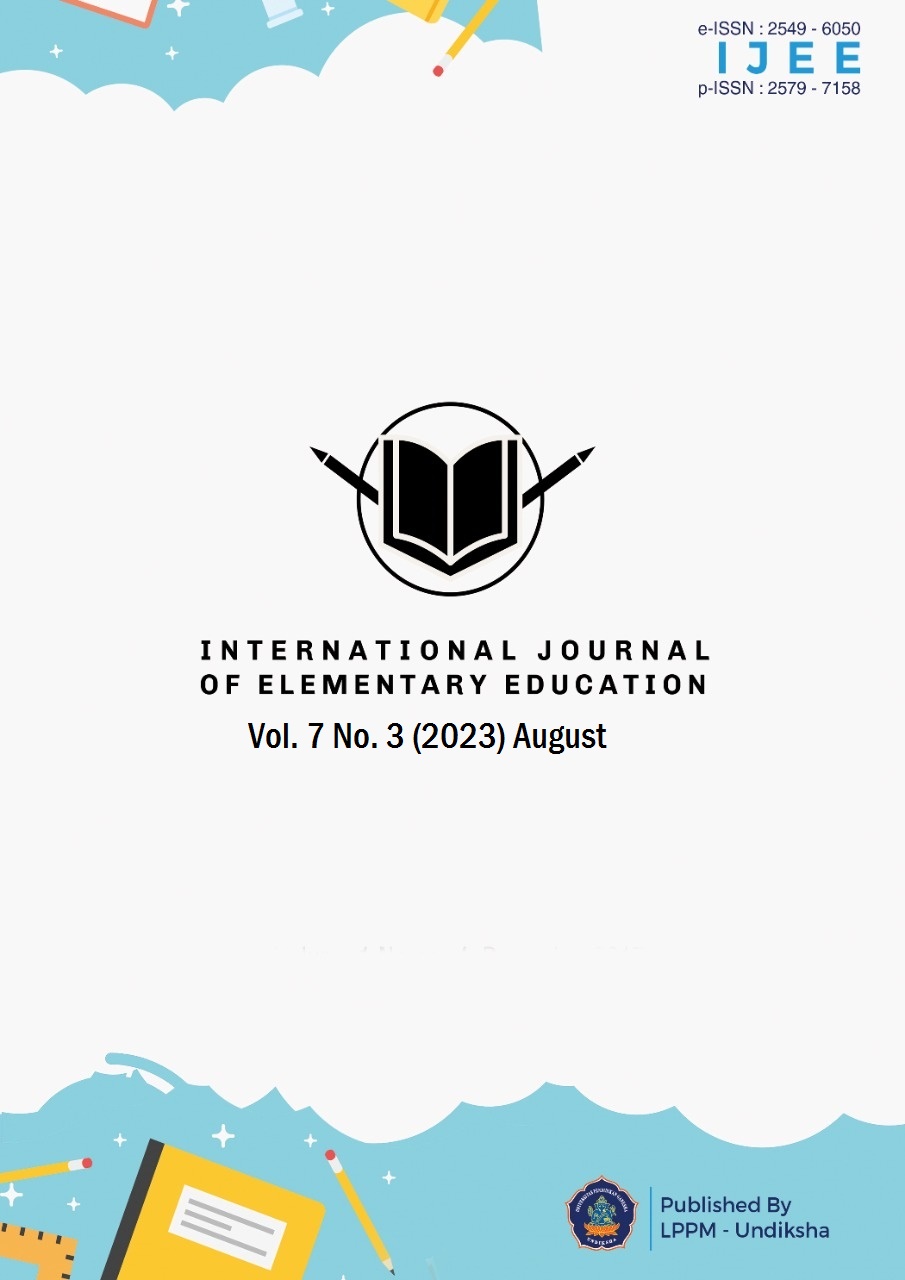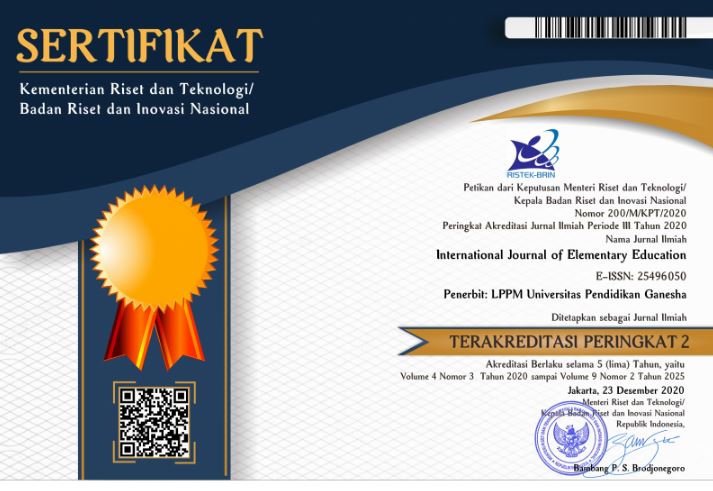The RADEC Learning Model Improves Explanatory Text Writing Skill in Elementary Schools
DOI:
https://doi.org/10.23887/ijee.v7i3.62068Keywords:
RADEC, Explanatory Text Writing Skills, Elementary SchoolAbstract
The skill of writing explanatory text is an essential skill to be mastered by elementary school students. However, most students still have low explanatory text writing skills. The purpose of this study was to analyze the Read, Answer, Discuss, Explain, and Create (RADEC) model in improving the writing skills of explanation texts of fifth grade elementary school students. This study used a quantitative approach with a Quasi Experimental Design type of Nonequivalent Control Group Design. The population in this study were fifth grade elementary school students consisting of two groups. The technique of determining the sample is purposive sampling. The data collection method in this study was a test using an explanatory text writing assessment rubric. Data analysis techniques in this study are descriptive statistical analysis and inferential statistical analysis. The results showed that there were significant differences in the skills of writing explanatory texts between the group that applied the RADEC model and the group that applied the conventional method. Thus, the RADEC model can improve the skills of writing explanatory texts of fifth grade elementary school students.
References
Birhan, A. T. (2018). Effects of mastery learning instruction on engineering students’ writing skills development and motivation. Journal of Language and Education, 4(4), 20–30. https://doi.org/10.17323/2411-7390-2018-4-4-20-30. DOI: https://doi.org/10.17323/2411-7390-2018-4-4-20-30
Cer, E. (2019). The Instruction of Writing Strategies: The Effect of the Metacognitive Strategy on the Writing Skills of Pupils in Secondary Education. SAGE Open, 9(2). https://doi.org/10.1177/2158244019842681. DOI: https://doi.org/10.1177/2158244019842681
Charkaluk, M. L., Rousseau, J., Benhammou, V., Datin-Dorrière, V., Flamant, C., Gire, C., Kern, S., Pierrat, V., Kaminski, M., & Marret, S. (2019). Association of Language Skills with Other Developmental Domains in Extremely, Very, and Moderately Preterm Children: EPIPAGE 2 Cohort Study. Journal of Pediatrics, 208, 114–120 5. https://doi.org/10.1016/j.jpeds.2018.12.007. DOI: https://doi.org/10.1016/j.jpeds.2018.12.007
Chou, M. H. (2018). Speaking Anxiety and Strategy Use for Learning English as a Foreign Language in Full and Partial English-Medium Instruction Contexts. TESOL Quarterly, 52(3), 611–633. https://doi.org/10.1002/tesq.455. DOI: https://doi.org/10.1002/tesq.455
Haerazi, & Haerazi, J. (2020). Mobile Applications to Improve English Writing Skills Viewed from Critical Think.pdf (pp. 58–72). DOI: https://doi.org/10.3991/ijim.v14i07.11900
Handayani, H., Sopandi, W., Syaodih, E., Suhendra, I., & Hermita, N. (2019). RADEC: An Alternative Learning of Higher Order Thinking Skills (HOTs) Students of Elementary School on Water Cycle. Journal of Physics: Conference Series, 1351(1). https://doi.org/10.1088/1742-6596/1351/1/012074. DOI: https://doi.org/10.1088/1742-6596/1351/1/012074
Hulme, C., Snowling, M. J., West, G., Lervåg, A., & Melby-Lervåg, M. (2020). Children’s Language Skills Can Be Improved: Lessons From Psychological Science for Educational Policy. Current Directions in Psychological Science, 29(4), 372–377. https://doi.org/10.1177/0963721420923684. DOI: https://doi.org/10.1177/0963721420923684
Ilankumaran, M., & Deepa, P. (2018). Teaching literature enhances communication skills - A study with special emphasis on poetry. International Journal of Engineering and Technology(UAE, 7(3), 187–191. https://doi.org/10.14419/ijet.v7i3.6.14967. DOI: https://doi.org/10.14419/ijet.v7i3.6.14967
Imelda, C., Y., B., & Astuti, U. P. (2019). Effect of process writing approach combined with video-based mobile learning on Indonesian EFL learners’ writing skill across creativity levels. International Journal of Instruction, 12(3), 325–340. https://doi.org/10.29333/iji.2019.12320a. DOI: https://doi.org/10.29333/iji.2019.12320a
Karataş, T. Ö., & Tuncer, H. (2020). Sustaining language skills development of pre-service EFL teachers despite the COVID-19 interruption: A case of emergency distance education. Sustainability (Switzerland, 12(19). https://doi.org/10.3390/su12198188. DOI: https://doi.org/10.3390/su12198188
Khairullah, Syambasril, & Wartiningsih, A. (2019). Learning to Write Explanatory Texts for Class XI Students of SMAS Mujahidin Pontianak Academic Year2018/2019. Equatorial Journal of Education and Learning, 8(3), 1–11. https://jurnal.untan.ac.id/index.php/jpdpb/article/view/31625.
Kharisma, A., Hartati, T., Damaianti, V. S., Solehuddin, M., & Chandra. (2022). Self Regulated Development Learning Model Based on Local Culture to Improve Elementary School Students’ Explanatory Writing Skills. Journal of Curriculum and Teaching, 11(8), 196–210. https://doi.org/10.5430/jct.v11n8p196. DOI: https://doi.org/10.5430/jct.v11n8p196
Kim, Y. S. G. (2020). Structural relations of language and cognitive skills, and topic knowledge to written composition: A test of the direct and indirect effects model of writing. British Journal of Educational Psychology, 90(4), 910–932. https://doi.org/10.1111/bjep.12330. DOI: https://doi.org/10.1111/bjep.12330
Kotronoulas, G., Miguel, S., Dowling, M., Fernández-Ortega, P., Colomer-Lahiguera, S., Bağçivan, G., Pape, E., Drury, A., Semple, C., Dieperink, K. B., & Papadopoulou, C. (2023). An Overview of the Fundamentals of Data Management, Analysis, and Interpretation in Quantitative Research. Seminars in Oncology Nursing, 39(2), 151398. https://doi.org/10.1016/j.soncn.2023.151398. DOI: https://doi.org/10.1016/j.soncn.2023.151398
Krishnan, P. (2018). A review of the non-equivalent control group post-test-only design. Nurse Reasearcher, 26(2), 37–40. https://doi.org/10.7748/nr.2018.e1582. DOI: https://doi.org/10.7748/nr.2018.e1582
Lervåg, A., Hulme, C., & Melby-Lervåg, M. (2018). Unpicking the Developmental Relationship Between Oral Language Skills and Reading Comprehension: It’s Simple, But Complex. Child Development, 89(5), 1821–1838. https://doi.org/10.1111/cdev.12861. DOI: https://doi.org/10.1111/cdev.12861
Lestari, H., Sopandi, W., Sa’ud, U. S., Musthafa, B., Budimansyah, D., & Sukardi, R. R. (2021). The impact of online mentoring in implementing radec learning to the elementary school teachers’ competence in training students’ critical thinking skills: A case study during covid-19 pandemic. Jurnal Pendidikan IPA Indonesia, 10(3), 346–356. https://doi.org/10.15294/JPII.V10I3.28655. DOI: https://doi.org/10.15294/jpii.v10i3.28655
Ma’azi, H., & Janfeshan, K. (2018). The effect of Edmodo social learning network on Iranian EFL learners writing skill. Cogent Education, 5(1), 1–17. https://doi.org/10.1080/2331186X.2018.1536312. DOI: https://doi.org/10.1080/2331186X.2018.1536312
Merz, E. C., Maskus, E. A., Melvin, S. A., He, X., & Noble, K. G. (2020). Socioeconomic Disparities in Language Input Are Associated With Children’s Language-Related Brain Structure and Reading Skills. Child Development, 91(3), 846–860. https://doi.org/10.1111/cdev.13239. DOI: https://doi.org/10.1111/cdev.13239
Miralpeix, I., & Muñoz, C. (2018). Receptive vocabulary size and its relationship to EFL language skills. IRAL - International Review of Applied Linguistics in Language Teaching, 56(1), 1–24. https://doi.org/10.1515/iral-2017-0016. DOI: https://doi.org/10.1515/iral-2017-0016
Motallebzadeh, K., Ahmadi, F., & Hosseinnia, M. (2018). Relationship between 21st century skills, speaking and writing skills: A structural equation modelling approach. International Journal of Instruction, 11(3), 265–276. https://doi.org/10.12973/iji.2018.11319a. DOI: https://doi.org/10.12973/iji.2018.11319a
Nugraha, T., & Prabawanto, S. (2021). The Enhancement of Students’ Mathematical Conceptual Understanding Through RADEC Learning Model. Eduma : Mathematics Education Learning and Teaching, 10(2), 167. https://doi.org/10.24235/eduma.v10i2.9073. DOI: https://doi.org/10.24235/eduma.v10i2.9073
Nurzaiyanah, N., Hamsa, A., & Daeng, K. (2021). The Relationship Between Reading Interest and Figurative Language Mastery with Short Story Writing Skills. Journal of Asian Multicultural Research for Educational Study, 2(3), 16–24. https://doi.org/10.47616/jamres.v2i3.190. DOI: https://doi.org/10.47616/jamres.v2i3.190
Pae, T. I. (2019). A Simultaneous Analysis of Relations Between L1 and L2 Skills in Reading and Writing. Reading Research Quarterly, 54(1), 109–124. https://doi.org/10.1002/rrq.216. DOI: https://doi.org/10.1002/rrq.216
Pratama, Y. A., Sopandi, W., & Hidayah, Y. (2019). RADEC Learning Model (Read-Answer-Discuss-Explain And Create): The Importance of Building Critical Thinking Skills In Indonesian Context. International Journal for Educational and Vocational Studies, 1(2), 109–115. https://doi.org/10.29103/ijevs.v1i2.1379. DOI: https://doi.org/10.29103/ijevs.v1i2.1379
Ramadini, R., Murniviyanti, L., & Fakhrudi, A. (2021). Efektivitas Model Pembelajaran RADEC Terhadap Kemampuan Menulis Teks Eksplanasi Siswa di SD Negeri 06 Payung. Edumaspul: Jurnal Pendidikan, 5(2), 99–104. https://doi.org/10.33487/edumaspul.v5i2.1647. DOI: https://doi.org/10.33487/edumaspul.v5i2.1647
Ramsook, K. A., Welsh, J. A., & Bierman, K. L. (2020). What you say, and how you say it: Preschoolers’ growth in vocabulary and communication skills differentially predict kindergarten academic achievement and self-regulation. Social Development, 29(3), 783–800. https://doi.org/10.1111/sode.12425. DOI: https://doi.org/10.1111/sode.12425
Riad, R., Allodi, M. W., Siljehag, E., & Bölte, S. (2023). Language skills and well-being in early childhood education and care: a cross-sectional exploration in a Swedish context. Frontiers in Education, 8(May), 1–16. https://doi.org/10.3389/feduc.2023.963180. DOI: https://doi.org/10.3389/feduc.2023.963180
Satria, E., & Sopandi, W. (2019). Applying RADEC model in science learning to promoting students’ critical thinking in elementary school. Journal of Physics: Conference Series, 1321(3). https://doi.org/10.1088/1742-6596/1321/3/032102. DOI: https://doi.org/10.1088/1742-6596/1321/3/032102
Schoonen, R. (2019). Are reading and writing building on the same skills? The relationship between reading and writing in L1 and EFL. Reading and Writing, 32(3), 511–535. https://doi.org/10.1007/s11145-018-9874-1. DOI: https://doi.org/10.1007/s11145-018-9874-1
Setiawan, D., Hartati, T., & Sopandi, W. (2019). Kemampuan Menulis Teks Eksplanasi Peserta didik Kelas 5 Sekolah Dasar melalui Model Read, Answer, Disscuss, Explain, And Create. Pendas: Jurnal Ilmiah Pendidikan Dasar, 4(1), 1–16. https://doi.org/10.23969/jp.v4i1.1575. DOI: https://doi.org/10.23969/jp.v4i1.1575
Slot, P. L., Bleses, D., Justice, L. M., Markussen-Brown, J., & Højen, A. (2018). Structural and Process Quality of Danish Preschools: Direct and Indirect Associations With Children’s Growth in Language and Preliteracy Skills. Early Education and Development, 29(4), 581–602. https://doi.org/10.1080/10409289.2018.1452494. DOI: https://doi.org/10.1080/10409289.2018.1452494
Sopandi, W. (2019). Sosialisasi dan Workshop Implementasi Model Pembelajaran RADEC Bagi Guru-Guru Pendidikan Dasar dan Menengah. Pedagogia : Jurnal Pendidikan, 8(1), 19–34. https://doi.org/10.21070/pedagogia.v8i1.1853. DOI: https://doi.org/10.21070/pedagogia.v8i1.1853
Sopandi, W., & Handayani, H. (2019). The Impact of Workshop on Implementation of (RADEC) Learning Model on Pedagogic Competency of Elementary School Teachers. International Conference of Innovation in Education (ICoIE, 178(ICoIE 2018), 7–11. https://doi.org/10.2991/icoie-18.2019.3. DOI: https://doi.org/10.2991/icoie-18.2019.3
Taguchi, N. (2018). Description and explanation of pragmatic development: Quantitative, qualitative, and mixed methods research. System, 75, 23–32. https://doi.org/10.1016/j.system.2018.03.010. DOI: https://doi.org/10.1016/j.system.2018.03.010
Winita, S., Ramadhan, S., & Asri, Y. (2020). The Development of Electronic Module Based on Discovery Learning in. Writing Explanation Text, 463, 63–69. https://doi.org/10.2991/assehr.k.200819.013. DOI: https://doi.org/10.2991/assehr.k.200819.013
Yusuf, Q., Jusoh, Z., & Yusuf, Y. Q. (2019). Cooperative Learning Strategies to Enhance Writing Skills among Second Language Learners. International Journal of Instruction, 12(1), 1399–1412. https://doi.org/10.29333/iji.2019.12189a. DOI: https://doi.org/10.29333/iji.2019.12189a
Downloads
Published
How to Cite
Issue
Section
License
Copyright (c) 2023 Andi Reza Hidayat

This work is licensed under a Creative Commons Attribution-ShareAlike 4.0 International License.
Authors who publish with the International Journal of Elementary Education agree to the following terms:
- Authors retain copyright and grant the journal the right of first publication with the work simultaneously licensed under a Creative Commons Attribution License (CC BY-SA 4.0) that allows others to share the work with an acknowledgment of the work's authorship and initial publication in this journal.
- Authors are able to enter into separate, additional contractual arrangements for the non-exclusive distribution of the journal's published version of the work (e.g., post it to an institutional repository or publish it in a book), with an acknowledgment of its initial publication in this journal.
- Authors are permitted and encouraged to post their work online (e.g., in institutional repositories or on their website) prior to and during the submission process, as it can lead to productive exchanges, as well as earlier and greater citation of published work. (See The Effect of Open Access)









